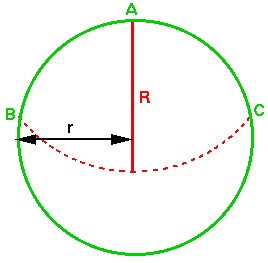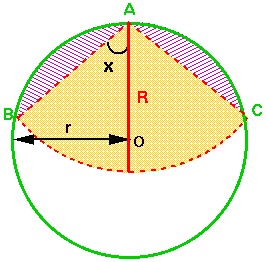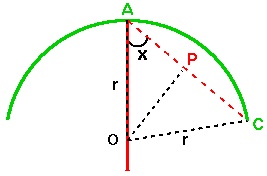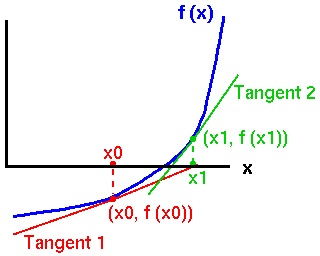Solution to Puzzle No. 8
For the question see Puzzle No 8 - The Gobbling Goat in issue 8.


Now, the area of the circle sector is: $$ {1\over 2} (R^2 . 2x) = R^2x $$ The area of each circle segment is: $$ (1/2)r^2(\pi-2x) - (1/2)r^2\sin(\pi-2x) $$ (because each is a sector of a circle minus a triangle) and so the total area accessible by the goat is: $$ R^2x + r^2[\pi - 2x - \sin(2x)] $$ (the yellow sector plus the two pink segments).

We can't easily solve the equation but we can use a graphical calculator or numerical method such as Newton-Raphson to find an approximate solution.
Using the Newton-Raphson method as described in the Coda, we find that $x$ is approximately $0.953$, and therefore $\cos x = 0.579$. \par Now, since $R = 2r \cos x$ and $r$, the radius of the field, is 100m, we have $R = 200 \cos x$ and thus the required length of rope is approximately 116m.
Coda: Solving the equation using Newton-Raphson
The basic idea
In the goat puzzle, we were left with the following equation to solve: $$ 4x \cos^2 x + \pi/2 - 2x - \sin(2x) = 0 $$ The Newton-Raphson method is an approximate method for finding roots of equations that are differentiable. \par Let $f(x)$ be a differentiable function. Since $f(x)$ is differentiable, every point on the graph of $f(x)$ must have a gradient and a unique tangent line. \par Now, the tangent at $x_0$ is an approximation to the graph of $f(x)$ near the point $(x_0,f(x_0))$. \par Therefore the zero of the tangent line (the point where the tangent line crosses the $x$-axis) is an approximation (perhaps a very bad one, however!) of the zero of $f(x)$ (the point where $f(x)$ crosses the $x$-axis, i.e. the root of $f(x)$). It's like we're pretending that $f(x)$ is really a straight line, like the tangent line, and therefore crosses the $x$-axis at the same place the tangent does.
In the Newton-Raphson method, we start with a "best guess" $x_0$ as to the zero of $f(x)$. We then calculate the first approximation, $x_1$, as the zero of the tangent line to $f(x)$ at $x_0$. \par We then calculate the second approximation, $x_2$, as the zero of the tangent line crossing the $x$-axis at $x_1$, and so forth. \par The diagram above shows the initial guess $x_0$, the first approximations $x_1$ and the relevant tangents. The second approximation $x_2$ is the coordinate where the second tangent crosses the $x$-axis. As you can see, the approximations are getting closer to the actual zero point of $f(x)$. If we continue iterating like this, we will get better and better estimates for the zero point of $f(x)$.
How do we do it?
We wish to solve $4x \cos^2 x + \pi/2 - 2x - \sin(2x) = 0$. Obviously, plotting $f(x) = 4x \cos^2 x + \pi/2 - 2x - \sin(2x)$ and drawing tangents is not going to be very much fun! However, we can perform Newton-Raphson numerically. \par Our initial point is $x_0$. The gradient of $f(x)$ at $x_0$ is given by $f'(x_0)$, and the tangent line to $f(x)$ at $x_0$ is therefore given by: $$ y - f(x_0) = f'(x_0) (x - x_0) $$ To find $x_1$, we must find the point where this tangent crosses the $x$-axis, i.e. to let: $$ 0 - f(x_0) = f'(x_0) (x_1 - x_0) $$ and therefore $$ x_1 - x_0 = \frac{-f(x_0)}{f'(x_0)} $$ so that $$ x_1 = x_0 - \frac{f(x_0)}{f'(x_0)} $$ Similarly, in the general case we obtain: $$ x_{n+1} = x_n - \frac{f(x_n)}{f'(x_n)} $$ \par Now, our function is $f(x) =4x \cos^2 x + \pi/2 - 2x - \sin(2x)$. Via standard differential calculus, the gradient $f'(x)$ of this function is $$ 4 \cos^2 x - 8x \cos x \sin x - 2 - 2 \cos(2x). $$ Therefore, to find the approximate root of $f(x)$ we can use the following: $$ x_{n+1} = {x_n} - \frac{4x_n \cos^2 x_n + \pi/2 - 2x_n - \sin(2x_n)} {4\cos^2 x_n - 8x_n \cos x_n \sin x_n - 2 - 2 \cos(2x_n)} $$ \par So, we know how to calculate $x_{n+1}$ from $x_n$. But how do we find our starting value, $x_0$? Well, in this particular case we know that the magnitude of $x$ must be between 0 and $\pi/2$ radians (go back to the second diagram and think about it if you're not sure why!). So a good initial guess might be (for example) $\pi/4$. \par As it turns out, all sorts of values will do: here's a table of the iterative steps of Newton-Raphson on our function $f(x)$ for a range of initial values of $x_0$. As you can see, they all converge quite rapidly to the same twelve-significant-digit approximation.| $x_0 = \pi/4$ | $x_0 = \pi/6$ | $x_0 = \pi/3$ | $x_0 = \pi/5$ | |
| $x_0$ | 0.785398163398 | 0.523598775598 | 1.047197551200 | 0.628318530718 |
| $x_1$ | 0.967088277216 | 1.200834484702 | 0.952802703860 | 1.050054911254 |
| $x_2$ | 0.952847864655 | 0.929999518111 | 0.952847865014 | 0.952745530049 |
| $x_3$ | 0.952847864655 | 0.952962588691 | 0.952847864656 | 0.952847866503 |
| $x_4$ | 0.952847864655 | 0.952847866978 | 0.952847868401 | 0.952847864653 |
| $x_5$ | 0.952847864655 | 0.952847864656 | 0.952847864655 | 0.952847864656 |
| $x_6$ | 0.952847864655 | 0.952847864655 | 0.952847864655 | 0.952847864655 |
Anonymous
the derivative wrt x of -sin(2x) is -2cos(2x), not -2sin(2x)cos(2x) as you have it in the solution to the goat problem. -- James Richard Spriggs at jrspriggs2000@yahoo.com
Marianne
Thanks very much for spotting the mistake, we've corrected it.